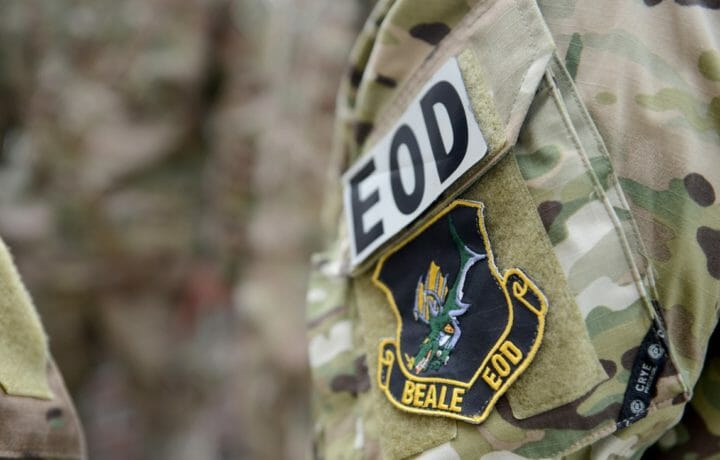Last month the Navy’s top SEAL ordered Naval Special Warfare Command to adopt the same stringent grooming and uniform standards required throughout the rest of the service – this included the wearing of so-called “morale patches.” This is a marked change for the SEAL community, which has adopted looser appearance rules, including beards, notably in war zones.
What exactly is a morale patch? The patches often feature humorous images and expressions, and are not authorized directly by the military to be worn on official uniforms. Likely in part for that reason, they’ve become popular with American soldiers and sailors serving in war zones and other remote areas of operation.
The United States Navy crackdown included scrutiny of any “politicized” morale patches – but the wearing of these patches, especially among those deployed, will likely continue as long as commanders on the ground don’t think they’ve crossed the line.
These morale patches are often used as identification with a particular unit, and actually grew out of official military shoulder insignia. While unique to the U.S. military, the British Army was apparently the first to adopt a type of “morale” insignia in the late 19th century as “Battle Patches,” which noted a unit’s engagement in a noteworthy battle. These were not the same as the actual unit “flash” or patch that the British adopted during the First World War.
History of Military Patches
The use of official unit patches in the U.S. military can be traced back to the American Civil War, when field uniforms become more “uniform.” Previously, units could be identified by the type of uniform, piping and other insignia. As the U.S. Army became larger the uniforms became more standardized – and some soldiers began to adorn their uniforms with an embroidered patch. These were typically made by mothers, wives and girlfriends on the home front.
Improvements in sewing machines and larger powered embroidery machines decreased the cost and increased the efficiency in which these patches could be made.
When the United States Army went “over there” to France in 1917 and 1918, American soldiers wore uniforms and steel helmets that at a glance were close in design to the British Army, which had already begun to wear formation signs at the divisional level to distinguish specific units.
Perhaps taking a cue from the British formation signs, the U.S Army’s 81st Infantry Division, which had trained at Fort Jackson, SC, became the first American unit to adopt the shoulder sleeve insignia or tactical patch. Because the troops had trained near a body of water known as Wildcat Creek, the patch featured a wildcat on an olive drab background.
The “Wildcat” Division’s unit patch was brought to the attention of the commander of American Expeditionary Force, General John J. “Blackjack” Pershing. The officer who reported it to Pershing thought the patch was “unbecoming of the uniform,” but Pershing – the only American to be promoted General of the Armies in his lifetime – felt otherwise and decided the 81st should keep the patch.
Moreover, Pershing suggested other divisions should also wear a distinctive patch. The Wildcat patch was officially recognized on October 19, 1918. It was the first of many to come. These were often created with symbolism alluding to the unit’s formation – such as the 82nd Infantry Division (Airborne Division), which was dubbed “All American” and featured an “AA” on the patch to denote that the unit was made up of soldiers from every state in the union.
From the First World War up until the Global War on Terror, typically soldiers had to sew their patches on the sleeve. Depending on the unit, this could be for the regiment, brigade or notably the division. The patch from the highest distinct echelon was the one that would be worn – so as an example, those in the 101st Airborne Division would wear that patch as opposed to the XVIII Airborne Corps.
The Army shoulder patches, officially known as shoulder sleeve insignia (SSI), are worn on the upper left arm of the Army combat uniform. Today, headquarters patches and the U.S. flag are worn on the right shoulder.
Combat veterans may also be authorized permanent wear of the SSI of the unit they served with on their right shoulder. This recognizes “former wartime service,” but it is frequently dubbed the “combat patch.”
Beginning during the Vietnam War, subdued patches (as well as insignia) were introduced and made mandatory for wear on the field uniform starting July 1, 1970.
Birth of the Modern Morale Patch
It was also during the Vietnam War that the modern “morale” patch was born. Individual soldiers created unofficial patches that often contained sarcastic, rude or critical statements. Unit commanders didn’t actually encourage these, but accepted the morale patch for the levity and camaraderie created. It was at this time the unofficial patches officially earned the moniker “morale patches.” Notable examples included such patches as “Viet Cong Hunting Club” and “Tonkin Gulf Yacht Club.”
U.S. Navy F-14s pilots reportedly adopted their own morale patches in 1981 after shooting down two Libyan Su-22 planes. The patch, which featured “Cool Cat” in a flight suit with the words “Anytime Baby…!” commemorated the first Gulf of Sidra incident and has inspired other “Top Gun” morale patches.
Morale patches have increased in use in recent years due to a Cold War era invention: Velcro!
At times when deployed, unit commanders might order soldiers to remove the official SSI patches. The use of hook-and-loop tape has allowed SSI to be added and removed as needed. But Velcro also made the wearing of morale patches when deployed all the easier, too, because with Velcro, an offending patch can be quickly removed should a superior not be amused by it.
Morale patches have also become prevalent in the military veteran community, where they’re worn on hats and jackets.
Despite the Navy’s efforts to unify and formilize grooming standards, the morale patch is likely one grooming trend that is here to stay.




